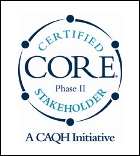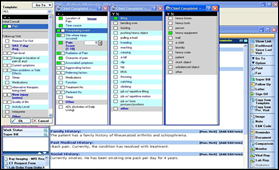Glen Tullman is CEO of Allscripts.

I know you’re about to release the financials for the first time since your merger, including like for like numbers for Allscripts and Misys. What will the numbers indicate about the success of the merger?
As you know, we can’t really talk about numbers. But I can talk a little bit about the merger.
There have been asked a lot of questions about, one year later, how does the merger look. Of course, the first place to go is the traditional metrics. We said that when we merged the companies we would deliver cost synergies. Those cost synergies would not just be by cutting people. In fact, today we have more people than we had a year ago. In the entire transaction, we lost very few people, only where there was absolute duplication. You don’t need two general counsels, for example; but net-net, we exceeded the annualized cost savings, so that’s metric one.
The second metric is how successful were you in getting the revenue synergies? The revenue synergies are really explained in two respects. One is what you saw in the first six months of the year with 30% year-over-year growth. From that perspective, it’s very aggressive sales growth, especially in electronic records.
Number two, we were able to do just what we said we’d do, and which was so critical to the success of the merger — that was to sell into the Misys space. The beauty of that was that there was an outside survey done that showed over 90% of the Misys clients indicating they would be upgrading their product. Now that said, we don’t take that for granted in any way. We work very hard on customer satisfaction; on making sure that customers understand what the products do, and understand how bright their future is.
Number three, what about innovation? Sometimes companies, when you do a big merger, they get distracted and they start focusing inward. Everything comes to a halt. People don’t know how to work with each other. What you saw at Allscripts is within the year that we’ve had been together as a one company we released more new versions, more new products than we have, ever, in the history of the company.
So things like having our electronic health record functionality available, not only on iPhones, but on the BlackBerry, on Windows Mobile, and looking beyond to the new iPad. We’re introducing a kiosk, which is the most sophisticated in the market; a brand new portal and new versions of our professional product. Last but not least, very substantial upgrades to the MyWay product, which is geared toward the smaller physician groups. So from that perspective, it was very successful.
Some of the innovation also came in areas like revenue cycle management, like what we have with Intuit that allows us to provide payer information to 30 million Quicken users. We’ve made it much easier to pay your bills and to know what you’re being billed for if you’re a Quicken user now. Then, something called mPay, which is a great advantage to physicians because those physicians now can get payment assurance.
The way a lot of people, especially our investors, look at it is what happened to the stock price. When we did this, there was a lot of uncertainty. People said, “Can they execute? Can they pull it off? Are they able to really deliver on it?” I think the stock price largely tells that story because when the deal was consummated, the stock price was roughly $5. Today, the stock price sits at roughly $20, so I think the market has voted and said this was a very successful merger.
All of that, I think, speaks very well of the success of the merger, one year later.
You touched on revenues. I know you can’t comment specifically, but of the revenues that are coming in, are the bulk of them coming from recurring revenue or sales to existing client base, or are you actually seeing increases in initial license fees that represent top line growth?
Let me talk first about the industry, because as an industry, we are starting to see the benefits of ARRA, the American Recovery and Reinvestment Act. We have said all along that there would be a nice steady growth each time we passed a milestone, starting with when ARRA was passed. Another one was when people started to understand what it meant. From there we went to Meaningful Use definition, and then Meaningful Use came out.
Each one of those picks up the level of interest in electronic health records and the level of demand and purchases of them. What I said all along is the next big pick up is going to be January 2011, when the first physician in the local area gets his or her check. What they’re going to say is, “Oh my gosh, it’s real.” A portion of the doctors are still saying, “I’ll believe it when I see it. When I see the first doctors start getting checks, that’s when I’m going to buy.”
Now that said, you asked specifically about our sales. What I would tell you is that Allscripts is, on the one hand, very blessed in that almost 67% of our revenues are recurring. That’s great until you look at growth rate because it makes it harder to get the growth rate up, so we talk a lot about the growth rate of new sales. If you’ve been following Allscripts, you’ll have seen a lot of the new sales activity outside the Misys space. We’re in a very fortunate position in part because healthcare needs us and because all the new physicians coming out that want an electronic health record.
Some young physicians say they won’t go to a practice without one. Then you put on top of that the stimulus, which effectively, in year one, gives somebody $18,000 for an electronic health record that probably costs just over half of that and you’ve got the seeds for very rapid growth. That is consistent in saying that we are seeing new demand, as well as continued demand from our existing clients to upgrade, to buy more training, to get ready for Meaningful Use.
You mentioned MyWay. It seems almost as if Allscripts really has two businesses, one that’s focused on the selling the inexpensive MyWay option to small practices through resellers and the other focused on selling to the large, integrated delivery networks and hospitals that subsidize the small practices and offering them the Allscripts EHR products. Explain the strategy and tell me how you avoid channel conflicts.
Channel conflicts are really a creation of salespeople who say, “How do I get paid for my customer?” That’s the only channel conflict that really exists. So what we’ve tried to do is create an end goal where our people get paid for getting clients to sign up. Consequently, maybe that means we pay a little more because in some cases, yes, we pay the channel and we pay our sales rep. When you’re willing to do that and eliminate any conflict, and make sure that instead of them fighting over whose sale it was, they’re fighting over the next client from a competitor. I think from that standpoint, some people might look at our business and say, “Gosh, you could save some money.” But we’d rather pay our sales rep, we’d rather compensate our channel partners and create a win/win.
We’ve worked very closely with the best channel partners in the business. When others like eClinical went out and said, “We’re going to go and get Walmart,” anybody in the industry knew that physicians aren’t going to go drive over to Walmart and write a check for $25,000 to get a new electronic medical record, take it back, and think they can get it up and running themselves. What happened is everybody looked at that and said, “Hey, great PR announcement.”
What we did instead was we went to people who’ve spent their lives working with physicians, building trust with them. People like Henry Schein, Cardinal Health, SYNNEX, then, of course, more recently, Dell Perot — all of whom built very solid relationships. Those are all distributors of our product. They come into the office and we give them not just a product, but years of a relationship.
So our sales strategy is yes, we sell direct and we have about 250 sales reps who do that. Next, we work closely, as you mentioned, with our largest clients, people like North Shore-Long Island Jewish. North Shore-Long Island bought 1,200 licenses for their employed physicians, then another 7,000 for the community and is helping us market those to their affiliated physicians.
This direct sales approach, working closely with our integrated delivery network and academic partners like North Shore-Long Island Jewish or on the West Coast people like Sharp, who we’re talking with; and others.
Then the third prong is the distributors that we already talked about, the Henry Scheins of the world. We also have distributors who kind of complement Henry Schein. A selected group of very high-quality distributors who are located around the country, who are just very very good, people like Etransmedia.
Last but not least, we have a big direct marketing operation.
It’s a five-pronged approach, and fortunately, it’s working very successfully.
What is Allscripts’ strategy to ensure it is well promoted by the RECs and how has the whole REC situation impacted your staffing requirements?
We think RECs, Regional Extension Centers, are going to be very helpful. The real key of the Regional Extension Centers is that they’re to become resources for providers to help accelerate adoption. What you really want to do is be one of the two or three products that they choose to promote. We’re working very hard to ensure that we one of the ones chosen with those parties. I think the advantage that we have there, and the reason why a Regional Extension Center would want to work with Allscripts, is because if the goal is getting people to install an electronic health record, then you want the fastest route to do that.
Remember how RECs gets paid. They get paid $5,000 for signing someone up, they get $5,000 once they go through the training, and they get paid $5,000 once there’s Meaningful Use. So if you’re an REC, your goal is how do I get there fastest? The last thing you want to do is go to a practice and say, “Now you have to either replace or put in a new practice management system.” That just slows you down.
With our system, given that 1/3 of all the physicians in the country already use some piece of Allscripts software, given the fact that a lot of those are practice management, our ability to work with an REC and quickly layer on top of that practice management a fully functional electronic health record, either a MyWay product or our professional product. That’s the fastest route for an REC to be successful. They are going to get measured and they do need to be successful. We think we have a real advantage to helping an REC become successful.
My understanding is that both the Epic and eClinicalWorks software packages allow users to exchange information between one another without any extra software, like an Allscripts Connect-like package. Is the software sharing approach something that Allscripts currently does or is planning to do?
You can answer that in a few ways. Epic is the least-connected system of any out there. I mean, we’re working today with Cerner, we’re working with Siemens, with Eclipsys. We’re working with our competitors, and in cases, we’re connected to eClin and Quality Systems.
The only people in the market who are fighting connectivity are Epic, and their strategy is to say, “Sure, you’re connected as long as everybody’s on one system and it’s the same version.” That’s not how healthcare in America is. Yeah, you can go to a virtual monopoly like Kaiser and force everyone to use it. But you know how healthcare is. Healthcare is diverse and I don’t think we’re ever going to a point where we are going to mandate every physician, “You have to use a certain system. You have to use Epic.” That strategy, that model, is a failed model.
Epic is not only against connectivity, but they’re anti-innovation. From that standpoint, they’re kind of exactly the opposite of the connectivity model that the rest of the industry is working toward.
But, as you said, one in three physicians in the country have some sort of connectivity to Allscripts. So, it seems intuitive that you’d want to make it easier to facilitate exchange of information.
I think we aren’t ready to make an announcement. But I think in a very short time, all our users will be able to be connected and have the ability to exchange information, and that’s where we’re headed. We’ve said that before, and those products are today being tested, which gives people the ability to refer to anyone on our network, and to exchange, easily, information.
Where it gets a little more complicated is where you do have multiple systems. There we have a solution as well, but what a lot of people try to do is simplify the process. The way they talk is they send a flat file, which is essentially sending somebody a picture. But what we’re working toward is multiple systems exchanging information. This is kind of a hard term, but it’s called semantic interoperability.
In an eClinical system, they may call sinusitis one thing and in our system we call it something else. Semantic interoperability will match those two names and know you’re talking about the same thing, and that’s what’s critical because just sending somebody a flat file and saying, “See, we’re exchanging information,” frankly, doesn’t get it done for things like comparative effectiveness and all of the value added stuff we want to do in the future.
I think you can look at a future where all of Allscripts clients are connected. That is where this business is moving. It went from practice management in wave one. Electronic health records are wave two. Wave three is about connectivity and information. It’s about providing physicians with the connectivity and information on those devices, those electronic health records, that they can use to make better decisions, both for higher quality care, and also for more cost-effective care.
We’re on wave two of a three-wave process. That’s why a lot of our R&D and a lot of our work is about information and connectivity as well.
As you know, GE just announced the acquisition of a new EMR vendor. What are your thoughts on that move, and will the industry be seeing more consolidation in the coming months?
I think the industry is going to see substantial consolidation. No industry in this country has more than five real competitors. You can’t support the level of innovation, the R&D, and the like that you need in technology without making a very substantial investment.
You’ve seen many of the larger companies make acquisitions, but they all run into the same problems. This is like hand-to-hand combat. What we do in Allscripts is we go physician to physician and work with those physicians and that’s not the model that a lot of many of the larger hospital companies have. They don’t get the same level of engagement that we have received. They’re top-down models, and in those models, somebody’s going to tell the physician what to do.
We have a very different model. Our model is about empowering physicians. GE is a great company. All of our competitors are the larger competitors in the market. They’re good companies and they will get some of the business, and we hope to get a little more than our fair share of the business. We are focused on our clients and empowering physicians. That’s our methodology; it’s not top-down.
I understand Allscripts has recently added a number of new members to its management team, including several from outside of healthcare IT. What’s your hiring strategy in terms of attracting talent from outside of healthcare?
I’d say a few things. One, if you look around the rest of the commercial and industrial sector, you’ll see a lot of innovation that you don’t see in healthcare. When we released our kiosk, people were amazed and they said, “Look, this is incredible innovation.” Then they went and they used an ATM at their bank and then they went to the airline and they checked in on an ATM. Then they went to their hotel, they used an ATM there. But in healthcare, that ATM was called innovation.
We think there’s a lot you can learn from bringing in expertise from other industries. A good part of leadership and management is the same, independent of industry. If you’re looking at someone to install software systems, you can just as easily look at Oracle or Computer Associates or a whole range of other companies who do that very well. You don’t have to strictly say, “Hey, let’s do it in healthcare.” But our strategy is a combination of people who bring healthcare experience and people who bring experience outside the industry, and it’s very relevant.
I think somebody recently said that we’re developing an industrial-strength management team and it’s one of the first in the industry. I think our strategy has been about building on success. We’re fortunate to have some very, very talented people at the company. But I think to supplement those, to build on our strengths, we’ve gone out and recruited some folks who can help us go to the next stage, because remember what’s coming. We’re taking a $4 billion industry and we’re injecting $40 billion. That’s 10x growth. When you do that, you want to make sure that you balance the talent you have with new talent. If you look at our COO, Eileen McPartland, she spent time with Gartner, she helped grow revenues at SAP from $100 million to a billion, then she went to Oracle.
Somebody like that coming in can take our culture, which is very physician-focused and client-focused, and then put process behind that as you grow, as you add hundreds of people, that understand process. I do want somebody in there that knows how to grow.
John Zimmerman, who heads Solutions Management, he’s a great blend because he spent 12 years at IBM, but then he spent 12 years at Siemens, all focused on solutions management. Richard Sills came to us from Computer Associates, where he managed 2,500 deployment people. If you’re going to deploy a lot of systems, you want to make sure you have people who’ve been through it before.
We have strength in the team, and ultimately, that’s going to result in something very simple: better client satisfaction and better delivery for our customers. That’s what it’s about.
What effect do you think healthcare reform will have on your business?
The best news about healthcare reform is that it’s done. What I mean by that is that our “healthcare reform” was ARRA. That provided the funding to allow us to make fundamental change. You know, you can’t transform healthcare without the information that you get from electronic health records. That was what President Obama clearly understood. But he also understood that just having the information wasn’t going to be enough unless you address the most vexing problem that we’ve had as a country, covering 35 or 40 million of our citizens.
What also concerned so many people were pre-existing conditions that an insurance company couldn’t exclude you because you had diabetes or you had some other ailment. So ARRA gave us the funding we needed, but without healthcare reform passing, there was a lot of uncertainty. Markets, especially growing markets, hate uncertainty. Now that it’s passed, everybody understands that we have healthcare reform and we hope to approach it intelligently and in a manner that is non-partisan.
Our role in that now gets easier because people say we have health reform and now we can go ahead and continue on our strategy of implementing electronic health records.
So it eliminates the diversion, perhaps?
It eliminates, exactly, distraction and diversion.
What other trends are we going to see in the industry in the next 12-18 months?
You know it’s funny, people have talked about Software as a Service, but when people say physicians want Software as a Service, I always kind of laugh. People talk a lot about technology, but physicians don’t. Physicians talk about getting their job done.
It’s kind of when we talk about phones. You and I don’t say, “Hey, does your phone company’s switching network work well?” All we want to know is how’s the reception from AT&T or Verizon, and, what kind of handset you have. Similarly with EHR, all physicians really want is to be shown a system that’s easy to install, easy to use, and easy to pay for.
We don’t really care what the technology is. If they want client/server, fine. If they want hosted, fine. If they want Software as a Service, fine. But what they really want to know is how much does it cost a month? How easy is it to install? What kind of support do I get? Can I get the Meaningful Use dollars? All those things, the answer with Allscripts is yes.
It’s not about technology because look at Epic using 25-year-old technology. If it was just about technology, they wouldn’t even be in the game, and they’re a very substantial player. It’s about who can make it easy to use. Who can make it easy to install.
I’ve given our folks the challenge of saying make this as easy to use as the video games that our kids have. You don’t need an instruction manual with those games. You just use it. That’s how we have to be.
I think another big trend is going to be health systems like UMass, like North Shore-Long Island Jewish, and others who are going to help the smaller physician groups get connected and adopt electronic health records. That’s clearly a big trend. We’re talking with a lot health systems.
Anything else you’d like to add?
I think the one other thing I’d say is that in some cases today, people are still making decisions based on features. I think it’s useful for people to start to say, “Which companies are going to be around three years from now, five years from now? Which companies are investing in R&D?”
There are a lot of smaller companies out there. You know, I’ve started enough small companies because I love small companies, but that said, right now the cost of playing is substantial. We’re spending $70 million this past year on R&D and that number’s going up. If you think about it, when you buy a system today, what are you going to say? Well, I want it to work on my iPhone because I don’t want to carry a separate device, but then that’s only a third of your physicians. And then you are going to say I want it to work on my BlackBerry, others will I want it to work on my Windows Mobile. Now we have people who need to get it to work on Droid.
For each one of those, to keep it up, to test it, to get it up and going costs a few hundred thousand dollars. So now you say, “Well what about portals? Would I want to be connected to HealthVault? I want to be connected to Google Health. I want to be connected to work with all these medical devices.” Now, the iPad comes out. Well, is this going to work on the iPad, right? When you start to look at that you say, “How are we, as a company, going to do all those things? How’s it going to connect?”
We have efforts going on to work with Cerner, to work with Eclipsys. How do you do all that and still meet commitments? I think it’s useful for people to start to say, “Look, one of the three criteria is this is a partnership that’s probably 5-10 years and is this is a company that’s going to be here; a company that’s investing in their future?” So I’d ask questions like what’s the management team like; what’s the size? Are they investing a lot in R&D because what I fear is a lot of people are going to buy systems from companies that won’t be around three years from now. Then all that money is going to be wasted and all the time and effort is going to be wasted.
I’d say a similar thing for people about certification. There’s a comprehensive certification and then there’s a lite certification. People who spend a lot of money trying to get a lite certification aren’t going to qualify, not only for the stimulus dollars, but they aren’t going to qualify for the increasing popular pay-for-performance and pay-for-value dollars that the industry’s going to provide. So if you’re going to do it, I’d suggest to people they look doing it right.
Those are, I think, two of the big areas to focus on when you select a vendor. Make sure that you check out whether they’re going to be around; make sure because remember, certification changes. It’s not just about getting certified Year One because that hurdle keeps getting higher. So we’re looking at making changes that you’re going to have to do 24 and 36 months from now.










Re: Walmart Health: Just had a great dental visit this morning, which was preceded by helpful reminders from Epic, and…